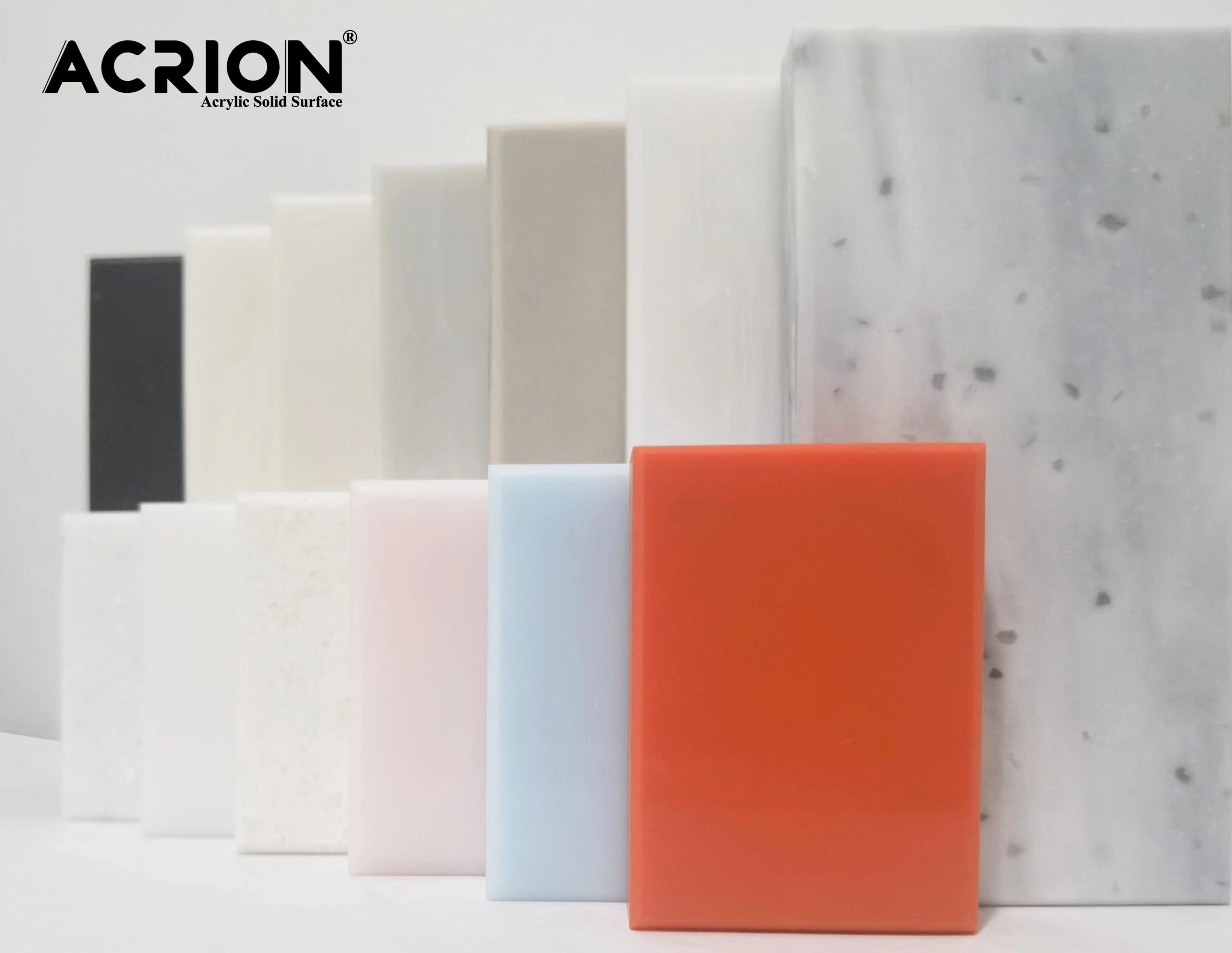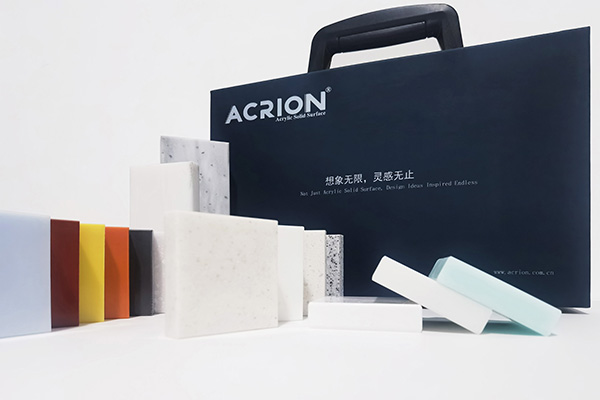Анализ антибактериальных и противогрибковых свойств на поверхности акрилового твердого вещества
На антибактериальные и противогрибковые характеристики акриловой твердой поверхности влияют технология модификации смолы, типы добавок и условия окружающей среды. Следующий анализ проводится из трех аспектов: антибактериальный механизм, противогрибковые показатели и влиятельные факторы:
Во -первых, источники и механизмы антибактериальных свойств
Допинг антибактериального агента
Антибактериальные функции могут быть наделены покрытием путем введения неорганических антибактериальных агентов (таких как оксид цинка, ионы серебра) или органические антибактериальные агенты (такие как соли четвертичного аммония) в акриловую смолу. Например, оксид цинка может генерировать фотокаталитическую активность при облучении ультрафиолетовым светом, высвобождая ионы цинка для разрушения клеточных мембран бактерий, тем самым ингибируя бактериальную пролиферацию. Эксперименты показывают, что акриловое покрытие, содержащее оксид цинка, все еще может поддерживать высокую антибактериальную активность после моделирования ежедневного износа. Высвобождение ионов цинка значительно увеличивается после обработки износа, и фотокаталитический антибактериальный эффект является выдающимся.
Технология модификации поверхности
Антибактериальные группы вводятся на поверхность акриловой смолы посредством химической прививки или физического смешивания. Например, смешивание силоксансодержащих антибактериальных агентов с акриловыми смолами может наделить поверхность покрытия гидрофобностью и антибактериальными свойствами, уменьшая бактериальную адгезию. Кроме того, введение нано-антибактериальных агентов (таких как нано-серебряные) может дополнительно повысить производительность антибактериальных результатов, но их диспергируемость необходимо контролировать, чтобы избежать агломерации.
Экологически отзывчивый антибактериальный
Некоторые акриловые покрытия могут вызывать антибактериальные механизмы с помощью стимулов окружающей среды, таких как влажность и свет. Например, в влажной среде скорость высвобождения антибактериального агента при ускорении покрытия ускоряется, тем самым усиливая антибактериальный эффект. Эта характеристика подходит для антибактериальных требований в средах с высокой влажностью, таких как ванные комнаты и кухни.
Во-вторых, производительность и влиятельные факторы антимолд-эффективности
Антимолд механизм
Производительность акрилового покрытия в основном зависит от его плотной поверхностной структуры и низкой скорости поглощения воды. Например, путем оптимизации формулы смолы и процесса отверждения, пористость поверхности покрытия может быть уменьшена, тем самым ингибируя адгезию и рост споров плесени. Кроме того, добавление фунгицидов (таких как изотиазолиноны) может дополнительно усилить эффект антимолда, но внимание следует уделять их совместимости с смолой.
Влияние условий окружающей среды
Рост плесени требует удовлетворения трех элементов: влаги, температуры и питательного субстрата. Например, в среде с температурой от 25 до 30 ℃ и влажностью ≥80% скорость роста плесени значительно ускоряется. Акриловое покрытие должно иметь хорошую водостойкость и воздухопроницаемость, чтобы скопление воды на поверхности не вызывало роста плесени. Кроме того, значение pH поверхности покрытия также влияет на эффективность защиты от плесени. Нейтральная или слабощелочная среда более способствует подавлению роста плесени.
Длительная долговечность
Производительность акрилового покрытия антимолд может снизиться со временем. Например, в наружной среде ультрафиолетовое излучение и эрозия дождя могут привести к потере поверхности покрытия и антимолд-агенту, что снижает антимолд. Следовательно, срок службы покрытия должен быть продлен путем добавления световых стабилизаторов и устойчивых к погодным условиям.
В -третьих, ключевые факторы, влияющие на антибактериальную и противогрибковую эффективность
Типы и дозировки антибактериальных агентов
Антибактериальный эффект неорганических антибактериальных средств (таких как оксид цинка и ионы серебра) длится долго, но может повлиять на прозрачность и механические свойства покрытия. Органические антибактериальные агенты (такие как соли четвертичного аммония) обладают высокой антибактериальной скоростью, но их термостойкость и долговечность относительно низкие. Например, чрезмерное содержание ионов серебра может привести к обесцвечиванию покрытия, а количество добавляемого оксида цинка необходимо контролировать на уровне 5–10 %, чтобы сбалансировать антибактериальные свойства и характеристики покрытия.
Характеристики смоляной матрицы
Температура стеклования (Tg) и плотность сшивки акриловой смолы влияют на скорость высвобождения антибактериальных средств. Например, смола с высоким Tg может замедлять высвобождение антибактериальных агентов и продлевать антибактериальный эффект; Умеренное сшивание может повысить плотность покрытия и снизить прилипание плесени. Кроме того, чем сильнее гидрофобность смолы, тем лучше ее защита от плесени.
Условия строительства и отверждения
Температура и влажность строительной среды влияют на эффект отверждения, а также на антибактериальные и противогрибковые свойства покрытия. Например, отверждение в условиях низкой температуры или высокой влажности может привести к неравномерному внутреннему напряжению в покрытии, снижающему его долговечность. Кроме того, время отверждения и интенсивность света также влияют на эффект сшивания и фиксации антибактериального агента.
В-четвертых, сценарии применения антибактериальных и противогрибковых свойств.
Медицинские учреждения
Требования к антибактериальным показателям для покрытий в больничных палатах, операционных и других местах чрезвычайно высоки. Например, акриловые антибактериальные покрытия могут наносить на стены и мебельные поверхности, чтобы снизить риск передачи бактерий. Такие покрытия должны обладать высокоэффективными антибактериальными свойствами (такими как скорость ингибирования ≥99% против Escherichia coli и Staphylococcus aureus) и долгосрочная долговечность.
Пищевая переработка
Загрязнение плесени в среде продовольствия должно строго контролироваться. Например, акриловое антимоловое покрытие может быть применено к стенкам мастерской и поверхностям оборудования, чтобы предотвратить рост плесени и загрязнение пищи. Такие покрытия должны иметь химическую устойчивость (например, устойчивость к кислотам, щелочкам и чистящим средствам) и низким выбросами ЛОС для удовлетворения требований безопасности пищевых продуктов.
Общественные здания
Стены и полы в общественных местах, таких как школы и торговые центры, подвержены микробному загрязнению. Например, акриловые антибактериальные и антимолдистые покрытия могут быть применены к часто троганным участкам, таким как ванные комнаты и кнопки лифта, снижая риск перекрестной инфекции. Такие покрытия должны быть устойчивыми к износу и простым в чистке, чтобы поддерживать долгосрочные антибактериальные эффекты.
В -пятых, стратегии повышения антибактериальной и противогрибковой эффективности
Составная антибактериальная система
Сложением неорганических антибактериальных агентов с органическими антибактериальными агентами, может быть достигнут антибактериальный эффект широкого спектра. Например, синергетический эффект оксида цинка и четвертичных антибактериальных агентов аммония может одновременно ингибировать рост бактерий и плесени. Кроме того, добавление фотокатализаторов (таких как диоксид титана) может усилить фотокаталитические антибактериальные показатели покрытия.
Поверхностная микроструктура контроль
Регулируя микроскопическую морфологию поверхности покрытия (такую как шероховатость и пористость), адгезия микроорганизмов может быть уменьшена. Например, применение сверхгидрофобной технологии поверхности может сделать угол контакта поверхности покрытия ≥150 °, тем самым ингибируя адгезию споров плесени. Кроме того, конструкция паттерна поверхности может также уменьшить площадь контакта для микроорганизмов.
Долголечие антимолд технологии
Время действия фунгицидов продлевается с помощью технологии медленного высвобождения. Например, фунгициды могут быть инкапсулированы в микрокапсулах, что позволяет постепенно высвобождать их во время применения покрытия, тем самым поддерживая долгосрочный фунгицидный эффект. Кроме того, добавление самовосстанавливающихся материалов может позволить покрытию автоматически ремонтировать себя после повреждения и восстановить свои антимолд-производительность.



